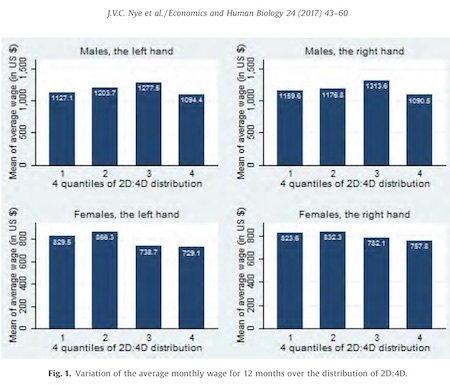Marc Abrahams's Blog, page 238
November 28, 2016
This is your brain on Scrabble™ : an fMRI study
It almost goes without saying that Improbable endeavours to keep our readers up-to-date with current fMRI research projects. In respect of which, may we recommend : ‘This is your brain on Scrabble: Neural correlates of visual word recognition in competitive Scrabble players as measured during task and resting-state’ published in the journal Cortex, Volume 75, February 2016, Pages 204–219.
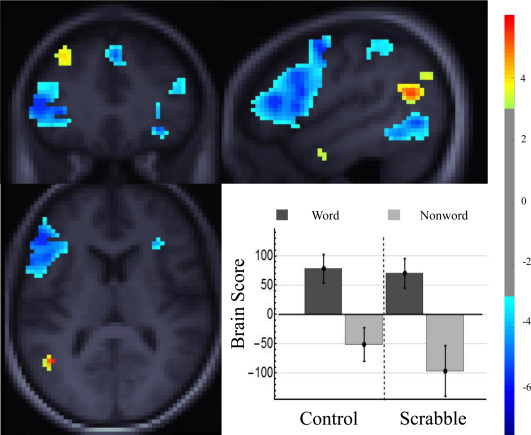 Also see: The 2012 Ig Nobel Prize for Neuroscience: awarded to Craig Bennett, Abigail Baird, Michael Miller, and George Wolford [USA], for demonstrating that brain researchers, by using complicated instruments and simple statistics, can see meaningful brain activity anywhere — even in a dead salmon.
Also see: The 2012 Ig Nobel Prize for Neuroscience: awarded to Craig Bennett, Abigail Baird, Michael Miller, and George Wolford [USA], for demonstrating that brain researchers, by using complicated instruments and simple statistics, can see meaningful brain activity anywhere — even in a dead salmon.
REFERENCE: ‘Neural correlates of interspecies perspective taking in the post-mortem Atlantic Salmon: An argument for multiple comparisons correction’ Craig M. Bennett, Abigail A. Baird, Michael B. Miller, and George L. Wolford, poster, 15th Annual Meeting of the Organization for Human Brain Mapping, San Francisco, CA, June 2009.
ALSO SEE: The Neural Bases of Disgust for Cheese: An fMRI Study
BONUS [fMRI related]: Differences Between Actual and Imagined Usage of Chopsticks

November 27, 2016
Relative Finger Lengths and Russian Wages
The famous “invisible hand” of economics is made visible in part — that part being the relative lengths of some of the fingers of laborers in Russia — in a newly published study.
The study is: “The Effects of Prenatal Testosterone on Wages: Evidence from Russia,” John V.C. Nye, Maksym Bryukhanov, Ekaterina Kochergina, Ekaterina Orel, Sergiy Polyachenko, Maria Yudkevich, Economics and Human Biology, vol. 24, 2017, pp. 43-60.
The authors, at George Mason University, USA, and National Research University Higher School of Economics, Moscow, explain:
“the relative length of the second to the fourth finger (2D:4D)… Though we do not yet understand the exact biological mechanisms… This paper uses a sample of working-age respondents from Moscow and the Moscow region to establish that [lower 2D:4D ratios] is clearly correlated with higher earnings for both women and men once controlling for factors such as age, education, and occupation.”
Here’s further detail from the study:
Next time you run into a professional economist, ask about this discovery. If you yourself are a professional economist, we would enjoy hearing how this discovery will change the way you understand the world economy.

A telling typo: High Hell Shoes
A typographical error, like a Freudian slip, can sometimes reveal a hidden truth. An example — the phrase “high hell shoes” — appears in this medical study:
“,” Anna Mika, Łukasz Oleksy, Edyta Mikołajczyk, Anna Marchewka, Medical Rehabilitation, vol. 13, no. 3, 2009, pp. 1-10. The authors, at the University School of Physical Education in Cracow, and the The McKenzie Institute Poland, write:
Results: A statistically significant increase in erector spine activity was observed in Trunk Flexion and during Flexion-Relaxation Position when wearing high hell shoes….
Conclusion: The prolonged wearing of shoes with stiletto type low and high heels by individuals without back pain is not safe for their spine and may lead to chronic paraspinal muscle fatigue.
Here’s some visual detail from the study:

(Thanks to Aleksandra Przegalinska for bringing this to our attention.)

November 26, 2016
Galam’s Work on Galam Models (Reviewed by Galam)
In 2008, French physicist Serge Galam wrote a review article about “Galam models,” in which he cited 71 papers, all of which were written or cowritten by him.
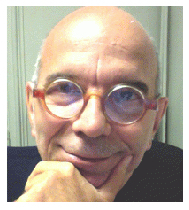
Serge Galam
Galam specializes in a topic known as “social physics” (or “sociophysics” for short), an area of complex systems that concerns the use of ideas and tools from physics to study collective social phenomena. Amidst the modern data deluge, sociophysics has become a very popular research area during the past decades, although the idea dates back multiple centuries and the term was first used more than two hundred years ago by French philosopher August Comte (1798–1857, credited as the founder of sociology).
There are numerous models in the physical study of social phenomena, and Galam reviewed the specific family of them known as “Galam models” in the article Sociophysics: A Review of Galam Models (available in published form at this website). The first sentence of the abstract provides a terse summary of the article’s contents: “We review a series of models of sociophysics introduced by Galam and Galam et al. in the last 25 years.” Below we excerpt the reference list (from the arXiv preprint of the paper) and show about half of the references.
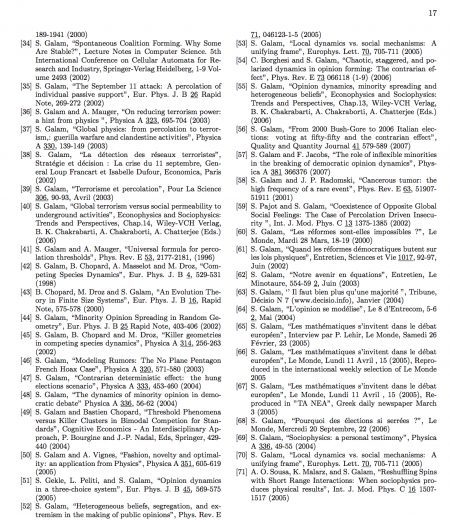
The second half of the 71 references, each authored or coauthored by S. Galam, in Serge Galam’s review article on Galam models.
Thanks to investigator Renaud Lambiotte for bringing this paper to our attention.

Disrupting inconspicuous consumption in laundry routines (studies)
“I think the jeans can’t smell any worse. You can’t get them any dirtier then what they already are, it’s like salt; you can only dissolve a certain amount of salt in water before the water can’t take any more in. It’s the same with jeans and smells and bacteria, you can only put so much in there, it can’t get any worse, it can’t hold any more.”
This is the kind of thing that can happen if, as part of a research project, you wear the same pair of jeans for three months without washing them :
“31 people in Melbourne [Australia] were engaged to wear the same pair of jeans for three months without washing them. Transcripts from interviews about their experience were used to draw insights on how individual courses of actions are shaped by collective conventions.”
By such methods, Tullia Jack who is a doctoral student of the Sociology dept. at Lund University, Sweden, has researched alternative laundering practices to make clothing more sustainable (i.e. by not washing them so often).
A full copy of the supporting 102 page thesis (from which the photo above was taken) and which includes details of the wearers’ olfactory responses (both favourable and decidedly unfavourable), may be found here. (Also featured as: Nobody was dirty: Intervening in inconspicuous consumption of laundry routines in the Journal of Consumer Culture, November 2013, vol. 13, no. 3)
BONUS : A video featuring the author from the University of Melbourne.
Related Note: A new paper in The International Journal of Consumer Studies informs about Reducing laundering frequency to prolong the life of denim jeans
“The findings from this study provide compelling evidence to encourage consumers to reconsider their laundering habits in terms of wash frequency as both a means to behave in a more environmentally sustainable way, and to preserve their favourite garments.”

November 25, 2016
Joseph’s Rube Goldberg machine for roasting a turkey
Here is Joseph. Joseph built a Rube Goldberg machine to roast a turkey. Joseph made a video of his Rube Goldberg machine roasting a turkey. This is that video:

(Thanks to Sarah Smith for bringing this to our attention.)

November 24, 2016
Influential imaginary scientists, in this time of influential imaginary facts
Why Fake Data When You Can Fake a Scientist?
Making up names and CVs is one of the latest tricks to game scientific metrics
That’s the headline on an article in Nautilus magazine, written by Adam Marcus and Ivan Oransky. Here’s part of the article:
…The fact is that professional advancement for scientists around the world is becoming more and more challenging in an era of ever-scarcer funding for research and tightening competition for faculty spots. To succeed in the publish-or-perish environment of academia, most scientists hit the lab and play within the rules. Others, though, hatch schemes….
[One] of today’s most direct new frauds is incredibly simple: Make up new people.
Jesus Angel Lemus is a Spanish veterinary researcher who has lost 13 papers to retraction over concerns about the veracity of his data. That part’s not so unusual—even 13 retractions doesn’t put Lemus among the top 30 researchers for retractions. What makes Lemus interesting is that he appears to have created a fictional co-author for five of his articles, one “Javier Grande” (big Xavier, whose vague affiliations, ironically enough, made him a big man on campus at the University of Castilla-La Mancha). It’s difficult to understand why, although bulking up author lists is one way to increase the apparent credibility of a study, particularly if they’re from a prestigious—or prestigious-sounding—institution….

November 23, 2016
Female Brain Size and Male Genitalia Length [new study]
Researchers in Sweden and Australia published a new study exploring how the length of males’ genitalia length affects the size of females’ brains. Anyone who reads the study discovers that
it’s about a species of tiny fish; and
the effect, if it happens, occurs over the span of many generations, possibly not so much with individual females and individual males.
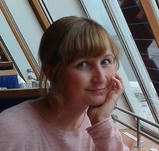 The study is: “Artificial Selection on Male Genitalia Length Alters Female Brain Size,” Séverine D. Buechel [pictured here], Isobel Booksmythe, Alexander Kotrschal, Michael D. Jennions, and Niclas Kolm, Proceedings of the Royal Society B, vol. 283, no. 1843, November 2016, 20161796. The authors, at Stockholm University, Sweden and The Australian National University, report:
The study is: “Artificial Selection on Male Genitalia Length Alters Female Brain Size,” Séverine D. Buechel [pictured here], Isobel Booksmythe, Alexander Kotrschal, Michael D. Jennions, and Niclas Kolm, Proceedings of the Royal Society B, vol. 283, no. 1843, November 2016, 20161796. The authors, at Stockholm University, Sweden and The Australian National University, report:
“We analysed the brains of eastern mosquitofish (Gambusia holbrooki), which had been artificially selected for long or short gonopodium, thereby mimicking selection arising from differing levels of male harassment. By analogy to how prey species often have relatively larger brains than their predators, we found that female, but not male, brain size was greater following selection for a longer gonopodium.”
Here’s further detail from the study:


Ig Nobel Prize ceremony, on Science Friday — The day-after-Thanksgiving tradition
 The Science Friday radio program will, for the 25th year, broadcast a specially edited version of the year’s Ig Nobel ceremony. In America, listening to the Ig on ScieFri on the day after Thanksgiving is a tradition. It’s the country’s biggest shared-experience science event.
The Science Friday radio program will, for the 25th year, broadcast a specially edited version of the year’s Ig Nobel ceremony. In America, listening to the Ig on ScieFri on the day after Thanksgiving is a tradition. It’s the country’s biggest shared-experience science event.
When: Friday, November 25, 2016
Where: Public radio (in the USA), and on the internet
How/where to listen: The Science Friday website lists radio stations and broadcast times. Many of those stations also livestream on the net.
Start time: In most places, the Ig Nobel ceremony will be HOUR TWO of the two-hour-long Science Friday program. (In the Boston area, though, it will be HOUR ONE on WBUR-FM 90.9, beginning at 2 pm.) Do check your local station to be sure about their start time.
It’s fun to hear the golden voice of SciFri host Ira Flatow set the scene. And for us (the organizers of the ceremony) its both fun and excruciating, in a different way each year, to see how the SciFri editors manage to almost magically squeeze a 90-minute-long event down into a radio hour that’s 47 minutes (of content) long.
Please gather the family around the Bunsen burner, and join us in listening to the Ig, on Friday, on SciFri. You might want to do, with your family at home, what the audience at the ceremony does in Harvard University’s Sanders Theatre: make paper and fly airplanes, directed strategically and with safety foremost in mind. Here’s a photo of a few of the 1100 people in the the audience in Sanders Theatre:


Teeth As a Dating Ornament (podcast #91)
Can your teeth make people want to date you or hate you? And how is toothbrushing like voting? We brush up on research studies that ask these questions, in this week’s Improbable Research podcast.
SUBSCRIBE on Play.it, iTunes, or Spotify to get a new episode every week, free.
This week, Marc Abrahams discusses two teeth-centric studies, with dramatic readings from Harvard chemist Daniel Rosenberg.
For more info about what we discuss this week, go explore:
“Should You Brush Your Teeth on 6 November, 1984?” A. Wuffle, Political Science, vol. 17, 1984, pp. 577–81.
“Evidence to Suggest That Teeth Act as Human Ornament Displays Signalling Mate Quality,” Colin A. Hendrie and Gayle Brewer, PLoS One, vol. 7, no. 7, epub July 31, 2012.
Here’s a bit of detail from the teeth/dating study:
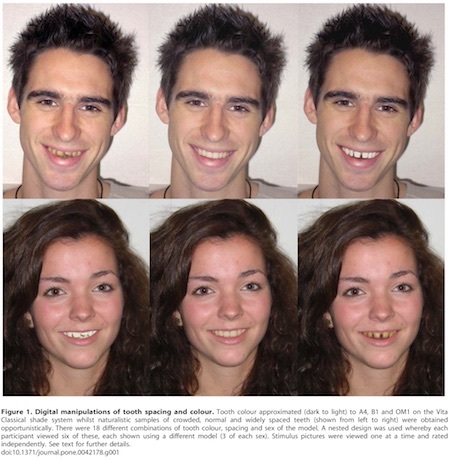
The mysterious John Schedler or the shadowy Bruce Petschek perhaps did the sound engineering this week.
The Improbable Research podcast is all about research that makes people LAUGH, then THINK — real research, about anything and everything, from everywhere —research that may be good or bad, important or trivial, valuable or worthless. CBS distributes it, on the CBS Play.it web site, and on iTunes and Spotify).
BONUS: A nice appreciation of Jean and her words, in the Huffington Post: “These Are The Words Even A Linguist Hates — This goes way beyond ‘moist.’ “

Marc Abrahams's Blog
- Marc Abrahams's profile
- 14 followers


